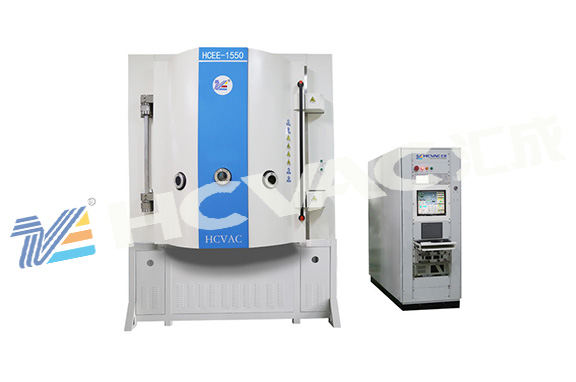The optical film of the pvd coating machine is realized in a high vacuum coating chamber. Conventional coating processes require elevated substrate temperatures; while more advanced technologies, such as ion-assisted deposition (IAD), can be performed at room temperature. The IAD process not only produces films with better physical properties than conventional coating processes, but can also be applied to substrates made of plastic.

In a conventional optical vacuum coating machine layout, two electron gun sources are located on both sides of the substrate, surrounded by an annular cover and covered by a baffle. The ion source is located in the middle, and the light control window is in front of the ion source. Figure 19.13 shows the top of a vacuum chamber containing a planetary system containing six circular clamps. Clamps are used to place coated optical components. Using a planetary system is the preferred method to ensure an even distribution of the material being vaporized within the clamp area. The clamp rotates around a common axis and simultaneously rotates around its own axis. The light control and crystal control are in the middle of the planetary drive mechanism, and the drive shaft blocks the crystal control. A large opening in the back leads to an additional high vacuum pump. The substrate heating system consists of 4 quartz lamps, two on each side of the vacuum chamber.
The traditional method of thin film deposition has been thermal evaporation, either using a resistive heating evaporation source or an electron beam evaporation source. The film properties are mainly determined by the energy of deposited atoms. The energy of atoms in traditional evaporation is only about 0.1eV. IAD deposition results in direct deposition of ionized vapor and adds activation energy to the growing film, typically on the order of 50 eV. The ion source directs the beam from the ion gun toward the substrate surface and the growing film to improve the film properties of traditional electron beam evaporation.
The optical properties of the film, such as refractive index, absorption and laser damage threshold, mainly depend on the microstructure of the film layer. Film material, residual air pressure, and substrate temperature may all affect the microstructure of the film. If the mobility of evaporatively deposited atoms on the substrate surface is low, the film will contain micropores. When the film is exposed to moist air, these micropores gradually fill with water vapor.
Packing density is defined as the ratio of the volume of the solid portion of the film to the total volume of the film (including voids and micropores). For optical films, the filling density is usually 0.75 to 1.0, mostly 0.85 to 0.95, and rarely reaches 1.0. Packing densities less than 1 give the evaporated material a lower refractive index than its bulk.
During the deposition process of an
optical pvd coating machine, the thickness of each layer is monitored optically or by a quartz crystal. Both technologies have their own advantages and disadvantages, which will not be discussed here. What they have in common is that they are all used in a vacuum when the material evaporates, so the refractive index is the refractive index of the evaporated material in a vacuum, not the refractive index of the material exposed to moist air. Moisture absorbed by the film displaces pores and voids, causing the film's refractive index to increase. Since the physical thickness of the film remains unchanged, this increase in refractive index is accompanied by a corresponding increase in optical thickness, which in turn causes the spectral characteristics of the film to shift toward longer wavelengths. To reduce this spectral shift caused by the volume and number of micropores within the film layer, high-energy ions are used to transfer their momentum to the evaporating material atoms, thereby greatly increasing the mobility of the material atoms during condensation at the substrate surface.



